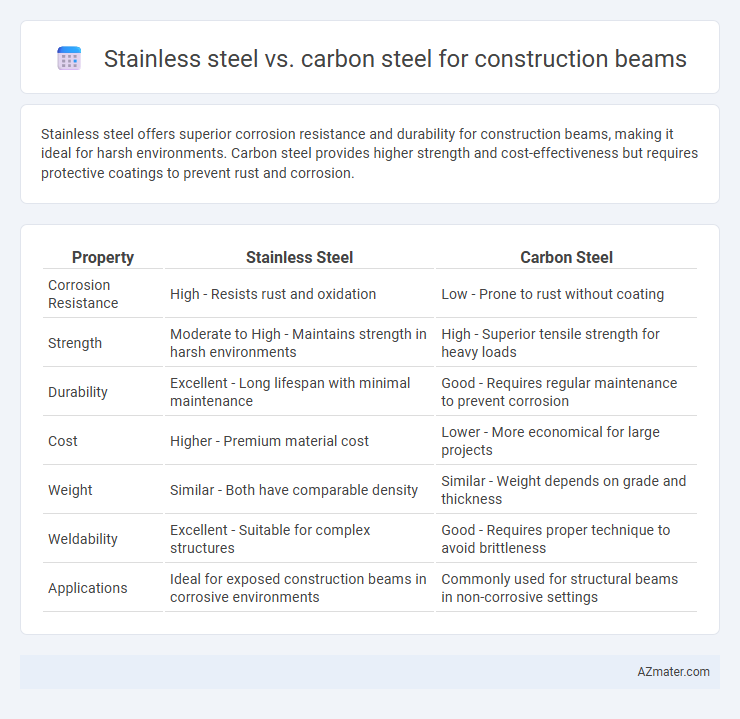Stainless steel offers superior corrosion resistance and durability for construction beams, making it ideal for harsh environments. Carbon steel provides higher strength and cost-effectiveness but requires protective coatings to prevent rust and corrosion.
Table of Comparison
| Property | Stainless Steel | Carbon Steel |
|---|---|---|
| Corrosion Resistance | High - Resists rust and oxidation | Low - Prone to rust without coating |
| Strength | Moderate to High - Maintains strength in harsh environments | High - Superior tensile strength for heavy loads |
| Durability | Excellent - Long lifespan with minimal maintenance | Good - Requires regular maintenance to prevent corrosion |
| Cost | Higher - Premium material cost | Lower - More economical for large projects |
| Weight | Similar - Both have comparable density | Similar - Weight depends on grade and thickness |
| Weldability | Excellent - Suitable for complex structures | Good - Requires proper technique to avoid brittleness |
| Applications | Ideal for exposed construction beams in corrosive environments | Commonly used for structural beams in non-corrosive settings |
Introduction to Steel Types in Construction
Stainless steel and carbon steel are fundamental materials used in construction beams, each offering distinct properties tailored to structural demands. Carbon steel is prized for its high tensile strength and affordability, making it a standard choice in load-bearing frameworks. Stainless steel provides superior corrosion resistance and requires minimal maintenance, ideal for environments exposed to moisture or chemicals.
Composition and Properties: Stainless Steel vs Carbon Steel
Stainless steel contains a minimum of 10.5% chromium, which provides exceptional corrosion resistance and prevents rust, making it ideal for construction beams exposed to harsh environments. Carbon steel primarily consists of iron with varying carbon content (up to 2%), offering higher tensile strength and lower cost but lower corrosion resistance compared to stainless steel. The composition differences directly influence properties such as durability, strength, and maintenance requirements in structural applications.
Strength and Durability Comparison
Stainless steel offers superior corrosion resistance and maintains strength in harsh environments, making it ideal for long-term structural durability in construction beams. Carbon steel provides higher tensile strength and is more cost-effective but requires protective coatings to prevent rust and reduce maintenance. Choosing between the two depends on the specific environmental conditions and load-bearing requirements of the construction project.
Corrosion Resistance in Construction Environments
Stainless steel offers superior corrosion resistance compared to carbon steel, making it ideal for construction beams exposed to moisture, chemicals, and harsh weather conditions. The chromium content in stainless steel forms a passive oxide layer that significantly reduces rust and degradation over time. Carbon steel beams require protective coatings or treatments to withstand corrosion, but they are generally more prone to rust in construction environments with high humidity or aggressive elements.
Cost and Economic Considerations
Carbon steel beams are generally more cost-effective than stainless steel for construction projects due to lower raw material and manufacturing expenses. Stainless steel offers superior corrosion resistance and durability, which can reduce long-term maintenance and replacement costs, potentially offsetting the initial price premium. Economic considerations must balance the higher upfront investment of stainless steel against lifecycle savings in environments prone to corrosion or requiring high strength-to-weight ratios.
Weight and Structural Load Implications
Stainless steel beams are generally heavier than carbon steel beams due to their higher density, impacting overall structural weight. Carbon steel, being lighter, reduces dead load and may allow for lighter foundational support, crucial for large-scale construction projects. However, stainless steel provides superior corrosion resistance, which can offset maintenance costs and extend structural lifespan despite initial weight considerations.
Maintenance and Longevity Differences
Stainless steel beams exhibit superior corrosion resistance compared to carbon steel, reducing maintenance frequency and costs in construction applications exposed to moisture or chemicals. Carbon steel beams require regular protective coatings and inspections to prevent rust and deterioration, leading to higher long-term maintenance efforts. The inherent durability of stainless steel ensures longer structural lifespan and minimizes repairs, making it a preferred choice for projects prioritizing longevity and low upkeep.
Environmental Impact and Sustainability
Stainless steel offers higher corrosion resistance, reducing maintenance frequency and extending the lifespan of construction beams, which enhances sustainability by lowering resource consumption over time. Carbon steel requires protective coatings to prevent rust, leading to increased environmental impact through more frequent repairs and recoating processes using volatile organic compounds (VOCs). Lifecycle assessments show stainless steel's recyclability and durability contribute to a smaller carbon footprint, supporting eco-friendly construction practices.
Common Applications in Building Projects
Stainless steel beams are commonly used in construction projects requiring corrosion resistance, such as coastal buildings, chemical plants, and high-humidity environments, due to their durability and low maintenance. Carbon steel beams dominate structural frameworks in commercial, residential, and industrial buildings where high strength and cost-effectiveness are prioritized, especially for load-bearing applications. Both materials serve critical roles in building projects, with stainless steel preferred for longevity and aesthetic appeal, while carbon steel is favored for structural integrity and affordability.
Choosing the Right Steel for Your Construction Beam
Carbon steel offers high strength and affordability ideal for construction beams in standard load-bearing applications, while stainless steel provides superior corrosion resistance and durability, making it suitable for environments exposed to moisture or chemicals. Selecting the right steel depends on structural requirements, environmental exposure, and budget constraints to ensure longevity and safety. Evaluating factors such as tensile strength, maintenance needs, and cost-effectiveness is essential for optimal beam performance in construction projects.

Infographic: Stainless steel vs Carbon steel for Construction beam
 azmater.com
azmater.com